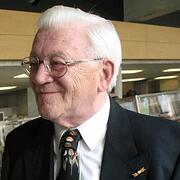Bruno Ernst (1926–2021)
Author of The Magic Mirror of M. C. Escher
About the Author
Disambiguation Notice:
Hans de Rijk wrote under the pseudonyms "Bruno Ernst" (on mathematics and sciences, including impossible figures), "Ben Elshout" (on photography and film) and "Ben Engelhart" (on scripts and graphology). Please don't separate these names.
Image credit: Bruno Ernst/Hans de Rijk
Works by Bruno Ernst
Naar beter handschrift 4 copies
Escherfoto's 2 copies
Snel werken met de rekenliniaal 2 copies
Inleiding tot de Calligrafie. Met Medewerking van T.Gourdie, H.Zapf, Martin Hermsdorf, E.Kuhn & C.Brand. (1966) 2 copies
Thieme's sterrenfotoboek 1 copy
Dossier 1 copy
Associated Works
M.C. Escher : his life and complete graphic work ; with a fully illustrated catalogue (1981) — Contributor — 604 copies, 6 reviews
Archimedes 25(1989)4 — Contributor, some editions — 1 copy
Tagged
Common Knowledge
- Canonical name
- Ernst, Bruno
- Legal name
- Rijk, Joannes Adrianus Friedrich de (Hans)
- Other names
- Engelhart, Ben
Ernst, Bruno
Elshout, Ben
Rijk, Hans de - Birthdate
- 1926-02-19
- Date of death
- 2021-11-23
- Gender
- male
- Nationality
- Netherlands
- Birthplace
- Rotterdam, Netherlands
- Place of death
- Utrecht, Netherlands
- Places of residence
- Rotterdam, Netherlands
Utrecht, Netherlands - Education
- Instituut Saint-Louis, Oudenbosch
- Occupations
- physicist
teacher - Relationships
- Escher, M.C. (Vriend)
- Organizations
- Volkssterrenwacht Simon Stevin te Oudenbosch (Founder)
Mercator (Founder)
Archimedes (Founder)
Pythagoras (Founder | 1961)
Ars et Mathesis (co-founder | 1983) - Awards and honors
- Eurekaprijs van NWO voor het beste oeuvre op het gebied van wetenschapscommunicatie(2008)
Officier in de Orde van Oranje-Nassau(2008) - Short biography
- His slogan is: Nescius omnium curiosum (I know nothing and am curious about everything)
- Disambiguation notice
- Hans de Rijk wrote under the pseudonyms "Bruno Ernst" (on mathematics and sciences, including impossible figures), "Ben Elshout" (on photography and film) and "Ben Engelhart" (on scripts and graphology). Please don't separate these names.
Members
Reviews
Lists
You May Also Like
Associated Authors
Statistics
- Works
- 27
- Also by
- 2
- Members
- 1,561
- Popularity
- #16,517
- Rating
- 4.1
- Reviews
- 6
- ISBNs
- 94
- Languages
- 10












A version put out by another publisher, Taschen, is a bit better than the one published by Tarquin. It is in a larger format, and contains many color illustrations and photographs which are shown only in black and white in the Tarquin version. The color photographs of models of impossible figures are somehow much more convincing than the black and white versions.… (more)